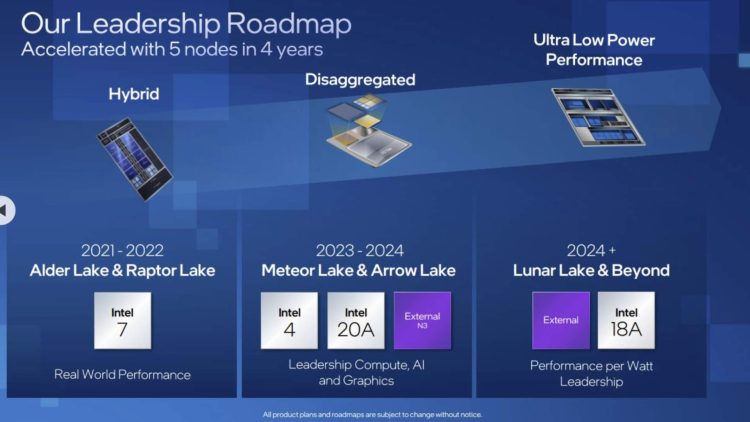Intel released a preview of what’s to come this week at the Hot Chips 34 tech conference, and there’s a good bit to get hyped over, in addition to some potentially troublesome signs. We can look forward to hearing all about Intel’s fancy tile-based next-gen CPU processors, with presentations on Meteor Lake, Lunar Lake, and Arrow Lake. What’s questionable is the amount of Intel 4 silicon that will actually go into these chips.
Intel put out an official press release but shared additional details early with Tom’s Hardware. According to the information, Meteor Lake is still on track for a 2023 release and will be Intel’s most advanced CPU design yet.
Performance where it counts
Meteor Lake CPUs will be composed of a CPU, GPU, IO, and SOC tile combined via Intel’s Foveros packaging tech to create a disaggregated chip. The idea behind this is to mix and match different densities of silicon based on what parts need the best performance. Using multiple tiles, or individual dies, to operate in a unified way will allow Intel to control costs while still stepping performance where it counts, like the CPU cores. This is because the more advanced, denser nodes cost significantly more to produce.
In theory, it’s a smart approach that will also let Intel do new things with smaller chips joined together while mitigating the complications and higher defect rates that come with producing large monolithic chips in the traditional fashion. Provided the new tech works as intended in the public computing ecosystem, it’s a strategy that should pay off. The capabilities of Meteor Lake are not the matter of question here, though.
What about in-house manufacturing?
Regardless of how Meteor Lake and subsequent architectures function, Intel’s marketing on how the chips will be manufactured is somewhat misleading based on info from multiple industry sources. As both Tom’s Hardware and SkyJuice from Angstronomics separately point out, Intel has contracted TSMC to manufacture the GPU, SOC, and IO tiles, while only the CPU tile and Foveros die will be made on Intel nodes.
It’s official. TSMC takes most of the active Silicon in Intel’s future PC processors!
Meteor Lake has 3 dies on TSMC and only 1 on Intel, sitting on a low-cost passive interposer!
This will ship over 100 million lifetime units!From PC Watch: https://t.co/8U7UFDhxjf https://t.co/XaxikFdEjb pic.twitter.com/APTMPV4DwJ
— SkyJuice (@SkyJuice60) August 22, 2022
Intel specifically markets its Intel 4 node for Meteor Lake, but that is apparently only true for the CPU tile which makes up a fraction of the total chip. According to these sources, there will be more TSMC silicon than Intel silicon on Intel’s own staple products. Keep in mind that Intel plans to reignite its reputation as a leading edge international foundry.
So what do we make of this? If this is indeed how Meteor Lake will be manufactured, it raises questions about the current projected yields and viability of the Intel 4 node. As we are all familiar with, Intel was years overdue with preparing its 10nm process for volume production to make Alder Lake. This was reportedly in part related to yield issues. This raises the question of whether Intel can reliably create enough advanced silicon to make its own chips and to what extent TSMC will subsidize production.

(Image credit: Intel).
With competitors rapidly advancing performance, it’s a tough thing to both design and manufacture cutting-edge silicon in today’s industry. AMD gave up that effort many years ago and moved to exclusively designing the chips and leaving manufacturing up to TSMC. Nvidia is also a customer of TSMC, and is using it for the RTX 40 Series. Conversely, Intel made a lot of noise when it announced its plans to reestablish itself as a leading chip manufacturer both for itself and the wider industry. Cost-effective volume is key to any successful silicon fab company.
With this in mind, it’s not reassuring to see this allegedly outsourced manufacturing strategy for Intel Meteor Lake. Team Blue needs to get a consistent grip on offering both the best designs and being able to saturate the market with plenty of products if it is to maintain its dominant role in the semiconductor industry. Whether or not Intel begins to consistently rely on its traditional competitors is something to keep a close eye on over the next few years.
